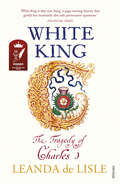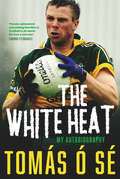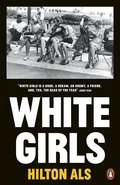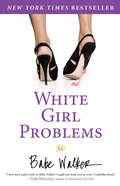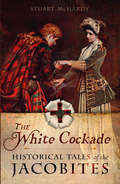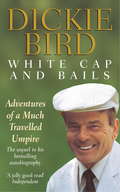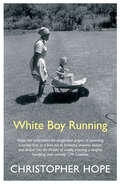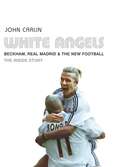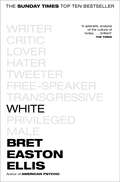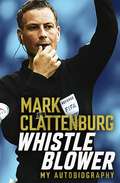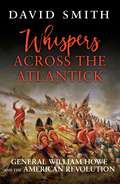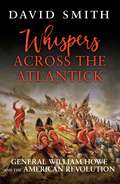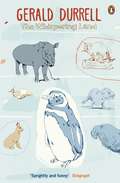- Table View
- List View
The White King: Charles I, Traitor, Murderer, Martyr
by Leanda de LisleFrom the New York Times bestselling author and master of narrative nonfiction comes the tragic story of Charles I, his warrior queen, Britain's civil wars and the trial for his life.Less than forty years after England's golden age under Elizabeth I, the country was at war with itself. Split between loyalty to the Crown or to Parliament, war raged on English soil. The English Civil War would set family against family, friend against friend, and its casualties were immense--a greater proportion of the population died than in World War I.At the head of the disintegrating kingdom was King Charles I. In this vivid portrait--informed by previously unseen manuscripts, including royal correspondence between the king and his queen--Leanda de Lisle depicts a man who was principled and brave, but fatally blinkered.Charles never understood his own subjects or court intrigue. At the heart of the drama were the Janus-faced cousins who befriended and betrayed him--Henry Holland, his peacocking servant whose brother, the New England colonialist Robert Warwick, engineered the king's fall; and Lucy Carlisle, the magnetic 'last Boleyn girl' and faithless favorite of Charles's maligned and fearless queen.The tragedy of Charles I was that he fell not as a consequence of vice or wickedness, but of his human flaws and misjudgments. The White King is a story for our times, of populist politicians and religious war, of manipulative media and the reshaping of nations. For Charles it ended on the scaffold, condemned as a traitor and murderer, yet lauded also as a martyr, his reign destined to sow the seeds of democracy in Britain and the New World.
White King: The tragedy of Charles I
by Leanda De LisleLess than forty years after the golden age of Elizabeth I, England was at war with itself. The bloody, devastating civil wars set family against family, friend against friend. At the head of this disintegrating kingdom was Charles I. His rule would change the face of the monarchy for ever. Charles I’s reign is one of the most dramatic in history, yet Charles the man remains elusive. Too often he is recalled as weak and stupid, his wife, Henrietta Maria, as spoilt and silly: the cause of his ruin. In this portrait -- informed by newly disclosed manuscripts, including letters between the king and his queen -- Leanda de Lisle uncovers a Charles I who was principled and brave, but also fatally blinkered. He is revealed as a complex man who pays the price for bringing radical change; Henrietta Maria as a warrior queen and political player as impressive as any Tudor. Here too are the cousins who befriended and betrayed them: the peacocking Henry Holland, whose brother engineered the king’s fall; and the magnetic ‘last Boleyn girl’, Lucy Carlisle.This is a tragic story for our times, of populist politicians and religious war, of a new media and the reshaping of nations, in which women vied with men for power. For Charles it ended on the scaffold. Condemned as a traitor and murderer, he was also heralded as a martyr: his reign destined to sow the seeds of democracy across Britain and the New World.
The White Heat – My Autobiography: Growing Up in Ireland’s Greatest GAA Dynasty
by Tomás Ó Sé‘I went as hard as I could for as long as I could’When Tomás Ó Sé retired from the Kerry senior panel in 2013, he did so as one of the longest-serving players in intercountry history and one of its most prolific winners. ‘Tomás epitomised everything that Kerry football is all about. His commitment, determination and never say die attitude were plainly visible every time he took to the pitch. He was a warrior and the best wing back that I have seen play the game.’Éamonn Fitzmaurice, Kerry senior team managerBut his drive and determination weren’t forged in a vacuum: they came from growing up in a family and place where Gaelic football was all that mattered. For Tomás and his brothers Marc and Darragh, football always came first – each of them inspired by the larger-than-life personality of their uncle Páidí, the talisman of Kerry’s fabled team of the early 1980s.In his memoir, an account of his upbringing and time in the Championship cauldron competing alongside and against the sport’s modern greats, Tomás writes candidly about life as a member of Ireland’s greatest sporting dynasty: the victories and disappointments, the rivals and roguery, the clashes and confrontations … not to mention the tremendous responsibility that came with donning the green and gold of Kerry.Moving, thrilling and frequently hilarious, The White Heat is an exploration of what it means to eat, sleep and bleed Gaelic Games.
White Hart Red Lion: The England of Shakespeare's Histories
by Nick AsburyTo this day The White Hart and The Red Lion are two of the most popular names for a public house in England – both talismans that served as the insignia for Richard II and the banished Henry Bolingbroke, Duke of Lancaster, who usurped the throne in 1399.Nick Asbury acted in the Royal Shakespeare Company’s famed Histories cycle which staged Shakespeare’s vision of the deposition of Richard II through to the notorious Battle of Bosworth in 1485. With fellow RSC actors for company, Nick travels the country visiting the buildings, landscapes and former sites of war and intrigue that feature in the plays, and asks the question: what is it about the England of Shakespeare’s Histories that continues to fascinate? From Alnwick to Eastcheap, Windsor Castle to a Leicester car park, this is his snapshot of England and its people, then and now.‘John Shakespeare, William’s father, was an Ale Taster before he was a glover and luminary of Stratford-upon- Avon, so in his footsteps I and my travelling players will be exploring the hostelries and byways of an England forged on the battlefields, triumphs and betrayals of TheHistories: on the one hand, Red – be it a pub or bloody Rose. On the other hand, White – be it the alabaster tombs of broken Princes or the quill of a playwright from Stratford-upon- Avon.’‘This bloody MG is so light it’s like driving a roasting tin. At the next turning, forewarned this time, I make the corner cheering victoriously and drive straight into a snow driftft that could swallow a bus let alone the mid-life crisis that is this MG. It turns out I am in the one area where it is as bad as they say it is. I dig myself out and reverse back on to the mainroad, all the time thinking life would be much better on a horse.’‘England, the tolerant bearer of religion that was the flower of the Northern Renaissance, was fast becoming a useless fist clothed in an old glove. It was fighting a war abroad, the cause of which it was not party to, and the execution of which was undermined by in-fighting at home. Plus ça change.’‘Geoffrey and I are swept like pooh sticks into Rouen. The road keeps tumbling down and the one time we want traffic lights to stop us, to catch our breath and to establish where we are, is of course the one time we are carried along on a river of green. We swoop into thecentral town square over cobbles that surely can’t be for everyday access, and on a hunch we turn right, only then realising that our hotel is in front of us and we have arrived. It’s the most remarkable entrance to a town I have ever made. We haven’t stopped once fornavigation, traffic lights or junctions and yet here we are.’
White Girls
by Hilton Als'I defy you to read this book and come away with a mind unchanged' John Jeremiah Sullivan'Als has a serious claim to be regarded as the next James Baldwin' Observer'I see how we are all the same, that none of us are white women or black men; rather, we're a series of mouths, and that every mouth needs filling: with something wet or dry, like love, or unfamiliar and savory, like love'White Girls is about, among other things, blackness, queerness, movies, Brooklyn, love (and the loss of love), AIDS, fashion, Basquiat, Capote, philosophy, porn, Louise Brooks and Michael Jackson. Freewheeling and dazzling, tender and true, it is one of the most highly acclaimed essay collections in years. 'A voice that's new, that comes as if from a different room. I defy you to read this book and come away with a mind unchanged' John Jeremiah Sullivan, author of Pulphead 'Effortless, honest and fearless' Rich Benjamin, The New York Times'Als is one of the most consistently unpredictable and surprising essayists out there, an author who confounds our expectations virtually every time he writes' David L. Ulin, Los Angeles Times 'A comprehensive and utterly lovely collection of one of the best writers around' Eugenia Williamson, Boston Globe
White Girl Problems
by Babe WalkerBabe Walker, center of the universe, is a painstakingly manicured white girl with an expensive smoothie habit, a proclivity for Louboutins, a mysterious mother she's never met, and approximately 50 bajillion Twitter followers. But her "problems" have landed her in shopping rehab-that's what happens when you spend $246,893.50 in one afternoon at Barneys. Now she's decided to write her memoir, revealing the gut-wrenching hurdles she's had to overcome in order to be perfect in every way, every day. Hurdles such as:I hate my horse. Every job I've ever had is the worst job I've ever had. He's not a doctor, a lawyer, or a prince. I'll eat anything, as long as it's gluten-free, dairy-free, low-carb, low-fat, low-calorie, sugar-free, and organic.In an Adderall-induced flash of inspiration, Babe Walker has managed to create one of the most enjoyable, unforgettable memoirs in years.
White Field, Black Sheep: A Lithuanian-American Life
by Daiva MarkelisHer parents never really explained what a D.P. was. Years later Daiva Markelis learned that “displaced person” was the designation bestowed upon European refugees like her mom and dad who fled communist Lithuania after the war. Growing up in the Chicago suburb of Cicero, though, Markelis had only heard the name T.P., since her folks pronounced the D as a T: “In first grade we had learned about the Plains Indians, who had lived in tent-like dwellings made of wood and buffalo skin called teepees. In my childish confusion, I thought that perhaps my parents weren’t Lithuanian at all, but Cherokee. I went around telling people that I was the child of teepees.” So begins this touching and affectionate memoir about growing up as a daughter of Lithuanian immigrants. Markelis was raised during the 1960s and 1970s in a household where Lithuanian was the first language. White Field, Black Sheep derives much of its charm from this collision of old world and new: a tough but cultured generation that can’t quite understand the ways of America and a younger one weaned on Barbie dolls and The Brady Bunch, Hostess cupcakes and comic books, The Monkees and Captain Kangaroo. Throughout, Markelis recalls the amusing contortions of language and identity that animated her childhood. She also humorously recollects the touchstones of her youth, from her First Communion to her first game of Twister. Ultimately, she revisits the troubles that surfaced in the wake of her assimilation into American culture: the constricting expectations of her family and community, her problems with alcoholism and depression, and her sometimes contentious but always loving relationship with her mother. Deftly recreating the emotional world of adolescence, but overlaying it with the hard-won understanding of adulthood, White Field, Black Sheep is a poignant and moving memoir—a lively tale of this Lithuanian-American life.
White Eskimo: Knud Rasmussen's Fearless Journey into the Heart of the Arctic (A Merloyd Lawrence Book)
by Stephen R. BownAmong the explorers made famous for revealing hitherto impenetrable cultures-T. E. Lawrence and Wilfred Thesiger in the Middle East, Richard Burton in Africa-Knud Rasmussen stands out not only for his physical bravery but also for the beauty of his writing. Part Danish, part Inuit, Rasmussen made a courageous three-year journey by dog sled from Greenland to Alaska to reveal the common origins of all circumpolar peoples. Lovers of Arctic adventure, exotic cultures, and timeless legend will relish this gripping tale by Stephen R. Bown, known as "Canada's Simon Winchester."
White Eskimo: Knud Rasmussen's Fearless Journey into the Heart of the Arctic (A Merloyd Lawrence Book)
by Stephen R. BownAmong the explorers made famous for revealing hitherto impenetrable cultures-T. E. Lawrence and Wilfred Thesiger in the Middle East, Richard Burton in Africa-Knud Rasmussen stands out not only for his physical bravery but also for the beauty of his writing. Part Danish, part Inuit, Rasmussen made a courageous three-year journey by dog sled from Greenland to Alaska to reveal the common origins of all circumpolar peoples. Lovers of Arctic adventure, exotic cultures, and timeless legend will relish this gripping tale by Stephen R. Bown, known as "Canada's Simon Winchester."
The White Cockade: Historical Tales of the Jacobites - an essential read for fans of OUTLANDER
by Stuart McHardyDuring the first half of the eighteenth century, Bonnie Prince Charlie and his diehard supporters – the Jacobites – almost changed the course of British history. Their attempts to drive out the house of Hanover and restore the Stuarts to the British throne is one of the great epics of history.In this book, acclaimed storyteller Stuart McHardy retells over forty Jacobite stories which date back to the time of the prince himself and his bitter defeat at the Battle of Culloden. Featuring the exploits of real people and actual events, and including tales of love, loyalty, bravery and treachery, The White Cockade opens a window into a remarkable world and features a huge cast of colourful characters.
White City
by Donald JamesOn the morning of 24th February 1944 following a devastating Luftwaffe raid, Donald Wheal and his family were homeless refugees with bulging suitcases and faces blackened by soot blast. In World's End, the first part of his bestselling childhood autobiography, he told of his upbringing during the Blitz in the rough working class community which was Chelsea's World's End. The morning after the World's End bombing he realized that the ties that had bound him to the past were now broken -- a new world and a new fate awaited him.In White City he tells the story of how his family, now menaced by the V-bombs and rockets that were the last stage of London's war, were re-settled in a anonymous London suburb where later his adolescence was to began amidst post war privation, sexual yearning and first love. In these dark years the quest for new experiences took him all around Britain and finally to war-ravaged France. A testing period of National Service in Germany and Italy completed his journey to adulthood.White City is as funny, heartbreaking and engaging as World's End
White Cap and Bails: Adventures of a much loved Umpire (Soundings (cds) Ser.)
by Dickie BirdIn this anecdotal book, the unstoppable Dickie Bird takes one County Cricket Club at a time and revisits each with the aid of memorabilia, statistics, books and videos. A mass of new hilarious stories flow from Dickie as he flexes his memory: he describes the cricketers, the matches and the character of these clubs. Dickie also relives his journeys as a umpire to clubs and Test match arenas overseas and recalls the humorous times that have filled his unique career. A must have for cricket enthusiasts everywhere.
White Boy Running
by Christopher HopeIn the run up to the 1987 election Christopher Hope returned to his native South Africa after a twelve-year absence. The nature of that year's whites-only election and the bitter defeat of the liberals led him to write this satirical, evocative portrait of what it looked and felt like growing up in a country gripped by an absurd, racist insanity.Full of exquisite and despairing descriptions, Hope weaves together journalistic commentary and his own personal story as he encounters the bloody battles that have divided his homeland. This is a mordantly witty account of escape, displacement and disillusionment, and a modern classic of journalistic memoir.
White Beech: The Rainforest Years
by Germaine GreerOne bright day in December 2001, sixty-two-year-old Germaine Greer found herself confronted by an irresistible challenge in the shape of sixty hectares of dairy farm, one of many in south-east Queensland that, after a century of logging, clearing and downright devastation, had been abandoned to their fate. She didn't think for a minute that by restoring the land she was saving the world. She was in search of heart's ease. Beyond the acres of exotic pasture grass and soft weed and the impenetrable curtains of tangled Lantana canes there were Macadamias dangling their strings of unripe nuts, and Black Beans with red and yellow pea flowers growing on their branches … and the few remaining White Beeches, stupendous trees up to forty metres in height, logged out within forty years of the arrival of the first white settlers. To have turned down even a faint chance of bringing them back to their old haunts would have been to succumb to despair. Once the process of rehabilitation had begun, the chance proved to be a dead certainty. When the first replanting shot up to make a forest and rare caterpillars turned up to feed on the leaves of the new young trees, she knew beyond doubt that at least here biodepletion could be reversed. Greer describes herself as an old dog who succeeded in learning a load of new tricks, inspired and rejuvenated by her passionate love of Australia and of Earth, most exuberant of small planets.
White Beech: The Rainforest Years
by Germaine GreerFor years I had wandered Australia with an aching heart. Everywhere I had ever travelled across the vast expanse of the fabulous country where I was born I had seen devastation, denuded hills, eroded slopes, weeds from all over the world, feral animals, open-cut mines as big as cities, salt rivers, salt earth, abandoned townships, whole beaches made of beer cans...One bright day in December 2001, sixty-two-year-old Germaine Greer found herself confronted by an irresistible challenge in the shape of sixty hectares of dairy farm, one of many in southeast Queensland that, after a century of logging, clearing, and downright devastation, had been abandoned to their fate. She didn't think for a minute that by restoring the land she was saving the world. She was in search of heart's ease. Beyond the acres of exotic pasture grass and soft weed and the impenetrable curtains of tangled Lantana canes there were Macadamias dangling their strings of unripe nuts, and Black Beans with red and yellow pea flowers growing on their branches … and the few remaining White Beeches, stupendous trees up to120 feet in height, logged out within forty years of the arrival of the first white settlers. To have turned down even a faint chance of bringing them back to their old haunts would have been to succumb to despair.Once the process of rehabilitation had begun, the chance proved to be a dead certainty. When the first replanting shot up to make a forest and rare caterpillars turned up to feed on the leaves of the new young trees, she knew beyond a doubt that at least here biodepletion could be reversed. Greer describes herself as an old dog who succeeded in learning a load of new tricks, inspired and rejuvenated by her passionate love of Australia and of Earth, the most exuberant of small planets.
White Angels: Beckham, the Real Madrid, and the New Football
by John CarlinA look at soccer superstar David Beckham, the Real Madrid team he joined in 2003, and at how this combination has forever changed the face of the world's most popular sport.
White American Youth: My Descent into America's Most Violent Hate Movement--and How I Got Out
by Christian PiccioliniAs featured on Fresh Air and the TED stage, a stunning look inside the world of violent hate groups by a onetime white supremacist leader who, shaken by a personal tragedy, abandoned his destructive life to become an anti-hate activist. Raw, inspiring, and heartbreakingly candid, White American Youth explores why so many young people lose themselves in a culture of hatred and violence and how the criminal networks they forge terrorize and divide our nation. The story begins when Picciolini found himself stumbling through high school, struggling to find a community among other fans of punk rock music. There, he was recruited by a notorious white power skinhead leader and encouraged to fight with the movement to "protect the white race from extinction." Soon, he had become an expert in racist philosophies, a terror who roamed the neighborhood, quick to throw fists. When his mentor was sent to prison, sixteen-year-old Picciolini took over the man's role as the leader of an infamous neo-Nazi skinhead group. Seduced by the power he accrued through intimidation, and swept up in the rhetoric he had adopted, Picciolini worked to grow an army of extremists. He used music as a recruitment tool, launching his own propaganda band that performed at white power rallies around the world. But slowly, as he started a family of his own and a job that for the first time brought him face to face with people from all walks of life, he began to recognize the cracks in his hateful ideology. Then a shocking loss at the hands of racial violence changed his life forever, and Picciolini realized too late the full extent of the harm he'd caused. "Simultaneously horrifying and redemptive" (AlterNet), White American Youth examines how radicalism and racism can conquer a person's way of life and how we can work together to stop those ideologies from tearing our world apart. *An earlier edition of this book was published as Romantic Violence
White: Writers On Cocaine
by Bret Easton EllisThe first non-fiction book by the author of American Psycho – a candid, fearless and provocative look at what is going on in the world right now.Bret Easton Ellis is most famous for his era-defining novel American Psycho and its terrifying anti-hero, Patrick Bateman. With that book, and many times since, Ellis proved himself to be one of the world’s most fearless and clear-sighted observers of society – the glittering surface and the darkness beneath.In White, his first work of non-fiction, Ellis offers a wide-ranging exploration of what the hell is going on right now. He tells personal stories from his own life. He writes with razor-sharp precision about the music, movies, books and TV he loves and hates. He examines the ways our culture, politics and relationships have changed over the last four decades. He talks about social media, Hollywood celebrities and Donald Trump. Ellis considers conflicting positions without flinching and adheres to no status quo. His forthright views are powered by a fervent belief in artistic freedom and freedom of speech. Candid, funny, entertaining and blisteringly honest, he offers opinions that are impossible to ignore and certain to provoke. What he values above all is the truth. ‘The culture at large seemed to encourage discourse,’ he writes, ‘but what it really wanted to do was shut down the individual.’ Bret Easton Ellis will not be shut down.
Whistled Like a Bird: The Untold Story of Dorothy Putnam, George Putnam, and Amelia Earhart
by Sally Putnam Chapman Stephanie MansfieldIn this extraordinary, true story about an independent woman, a world-famous aviator, and the powerful man who loved them both, Sally Putnam Chapman, the granddaughter of Dorothy Binney Putnam and George Putnam, recounts a treasure trove of memories, spanning the years 1907 to 1961, culled from her grandmother's diaries. of photos.
Whistle Blower: My Autobiography
by Mark ClattenburgThe outspoken and hard-hitting autobiography of one of the most highly-rated, recognisable and controversial football referees of modern times.Mark Clattenburg found himself in the centre circle, whistle in hand, at the start of 450 Premier League matches during a highly eventful 13-year career in football's top flight. He has shaken hands with, issued red and yellow cards to, and been sworn at by hundreds of players. He has been screamed at and shared jokes with dozens and dozens of managers. And he's felt the wrath of thousands upon thousands of irate fans.His autobiography is the ultimate guide to what it's really like to be in the referee's spotlight. It offers numerous intriguing insights into the daily trials and tribulations, the acute stresses and strains, of a top-flight referee. Clattenburg takes the reader into the referee's room, the players' tunnel and out on the pitch to experience precisely what a referee goes through on match day.
Whispers Across the Atlantick: General William Howe and the American Revolution
by David SmithGeneral William Howe was the commander-in-chief of the British forces during the early campaigns of the American Revolutionary War (1775-1783). Howe evoked passionate reactions in the people he worked with – his men loved him, his second-in-command detested him, his enemies feared him, his political masters despaired of him. There was even a plot to murder him, in which British officers as well as Americans were implicated. Howe's story includes intrigue, romance and betrayal, played out on the battlefields of North America and concluding in a courtroom at the House of Commons, where Howe defended his decisions with his reputation and possibly his life on the line. The inquiry, complete with witness testimonies and savage debate between the bitterly divided factions of the British Parliament, gives Howe's story the flavour of a courtroom drama. Using extensive research and recent archival discoveries, this book tells the thrilling story of the man who always seemed to be on the verge of winning the American Revolutionary War for Britain, only to repeatedly fail to deliver the final blow.
Whispers Across the Atlantick: General William Howe and the American Revolution
by David SmithGeneral William Howe was the commander-in-chief of the British forces during the early campaigns of the American Revolutionary War (1775-1783). Howe evoked passionate reactions in the people he worked with – his men loved him, his second-in-command detested him, his enemies feared him, his political masters despaired of him. There was even a plot to murder him, in which British officers as well as Americans were implicated. Howe's story includes intrigue, romance and betrayal, played out on the battlefields of North America and concluding in a courtroom at the House of Commons, where Howe defended his decisions with his reputation and possibly his life on the line. The inquiry, complete with witness testimonies and savage debate between the bitterly divided factions of the British Parliament, gives Howe's story the flavour of a courtroom drama. Using extensive research and recent archival discoveries, this book tells the thrilling story of the man who always seemed to be on the verge of winning the American Revolutionary War for Britain, only to repeatedly fail to deliver the final blow.
The Whispering Land: A Zoo In My Luggage, The Whispering Land, And Menagerie Manor (The\zoo Memoirs Ser. #2)
by Gerald Durrell'When you have a large collection of animals to transport from one end of the world to the other you cannot, as a lot of people seem to think, just hoist them aboard the nearest ship and set off with a gay wave of your hand.'Gerald Durrell and his wife are the proud owners of a small zoo on the island of Jersey. But there's one thing that's better than a small zoo - a bigger one! So Durrell heads off to South America to collect more animals.Along windswept Patagonian shores and in Argentine tropical forests, he encounters a range of animals from penguins to elephant seals. But as always, he is drawn to those rare and interesting creatures which he hopes will thrive and breed in captivity . . .Told with enthusiasm and without sentimentality, Gerald Durrell's The Whispering Land is an often hilarious but always inspiring foray into the South American wilds.
Whispering Hope - Nancy's Story: The True Story of the Magdalene Women
by Steven O'Riordan Nancy Costello"At the conclusion of my discussions with one group of the Magdalene Women one of those present sang 'Whispering Hope'. A line from that song stays in my mind - 'when the dark midnight is over, watch for the breaking of day'.Let me hope that this day and this debate heralds a new dawn for all those who feared that the dark midnight might never end."- Taoiseach Enda Kenny's State apology to the Magdalene women.On 19 February 2013 the Irish Taoiseach Enda Kenny apologised to the women who had been incarcerated in Ireland's Magdalene laundries. And listening patiently for the words she'd been fighting to hear was Nancy Costello.For Nancy was only 10 years old when she was confined at the Good Shepherd Sundays Well Magdalene laundry in Cork in 1949. From there she was sent to laundries in Limerick, Waterford and Wexford. The harrowing physical and psychological abuse she endured in the institutions, run on behalf of the State, led to a lifetime of shame and secrecy.Now, in WHISPERING HOPE, Nancy tells her story for the first time. Her fight for justice and forged friendships with other survivors has enabled her to move forward and have her voice heard in this immensely powerful narrative that shines a light on a dark chapter in Ireland's history.Inspirational and moving, this is the story of a remarkable woman brave enough to confront her past and strong enough to not let it define her.
Whispering Hope - Marina's Story: The True Story of the Magdalene Women
by Steven O'Riordan Marina Gambold"At the conclusion of my discussions with one group of the Magdalene Women one of those present sang 'Whispering Hope'. A line from that song stays in my mind - 'when the dark midnight is over, watch for the breaking of day'.Let me hope that this day and this debate heralds a new dawn for all those who feared that the dark midnight might never end."- Taoiseach Enda Kenny's State apology to the Magdalene women.n 19 February 2013 the Irish Taoiseach Enda Kenny apologised to the women who had been incarcerated in Ireland's Magdalene laundries. And listening patiently for the words she'd been fighting to hear was Marina Gambold.For Marina was only 16 years old when she was confined at the Good Shepherd convent in New Ross, Wexford in 1951. The harrowing physical and psychological abuse she endured in the institutions, run on behalf of the State, led to a lifetime of shame and secrecy.Now, in WHISPERING HOPE, Marina tells her story for the first time. Her fight for justice and forged friendships with other survivors has enabled her to move forward and have her voice heard in this immensely powerful narrative that shines a light on a dark chapter in Ireland's history.Inspirational and moving, this is the story of a remarkable woman brave enough to confront her past and strong enough to not let it define her.

